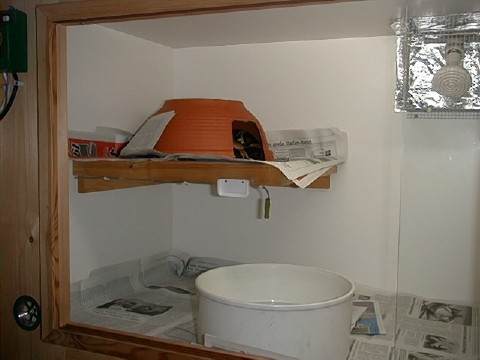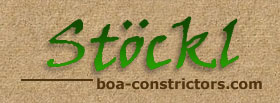The boa tank / terrarium / enclosure / cage substrate
Unfortunately, the perfect substrate does not exist. Need examples? Here you go:
- Sterilized soil or mulch conceals feces
- Gravel rocks let the urine seep through
- Wood shavings, sand, and seramis get into the animal’s mouth during feeding (and the dust gets in the nose)
- Artificial grass (the green stuff, you know) is difficult to clean, and will often retain some of the cleaning fluid
We have decided on newspaper as substrate. Professor Werner Frank from the Institute for Parasitology at the University of Hohenheim had introduced newspaper as substrate already in the 80ies. The newsprint acts slightly antibacterial and, contrary to public opinion does not harm the snakes (SCHAD, pers. comm.).
Newspaper is wonderful to handle, one can simply roll it up whenever the snakes have done their business; a little whipping afterwards, and its done. The enclosure should be completely cleaned at least once a month anyways. Newspaper as substrate significantly decreases the necessary effort involved. The only negative factor is the optical aspect, but the sight of a pretty snake will not be spoiled by anything.
Climbing branches in the boa tank / terrarium / enclosure / cage
Branches are especially crucial for arboreal boids. Tree pythons (Chondropython viridis) and emerald tree boas (Corallus caninus) would not be adequately kept without thick branches.
It is recommended to mount the branches in a way that allows for easy maintenance and quick dismount. To keep pests from entering the enclosure, all bark should be removed from the branches prior to use.
Instead of branches, we prefer removable shelves that can also be used for climbing. Snakes love these elevated shelves, and they are also easier to clean than branches.
Hide spots in the boa tank / terrarium / enclosure / cage
The proper husbandry of boids also requires a spot, at which the animals are able to hide. Suppliers offer terrarium cork bark for this purpose, which is normally readily accepted by boas and pythons. Unfortunately, those barks are not easy to clean. We therefore use clay pots that are normally used for plantings. A cutting tool can be utilized to cut an adequate opening for the snakes into the pot. The container is then placed upside down in the enclosure, and the hide box is ready to go. These clay pots can be washed (which you should definitely do from time to time), as well as heated in the oven, in order to kill harmful germs.
However, for a quarantine enclosure or poor people, a card box with a small opening for the snake to crawl in will do just fine.
 shelf with hideout. In the middle of the photo you can see the feeler of the thermostat
shelf with hideout. In the middle of the photo you can see the feeler of the thermostat
boa constrictor terrarium size | boa constrictor tank | boa constrictor cage | terrarium lighting | terrarium heating | boa terrarium heating cable | boa terrarium heating pads | boa terrarium ventilation | Boa constrictor terrarium materials | terrarium substrate | terrarium climbing branches | terrarium plants | tank hide spots | Terrarium humidity gauge | terrarium thermometer
Water container size in the boa tank / terrarium / enclosure / cage
Occasionally, some of the handymen among the snake keepers get the idea to install a built-in water container into the enclosure. This luxury pool is then outfitted with a separate drain, and becomes the pride of its maker.
But, our handyman has already made his first mistake at this point. The water container is the largest potential source of germs and bacteria in the enclosure. Pathogenic agents, such as Pseudomonas aeroginosa, which can cause infections in the stomach and intestine tract, as well as the lungs, prefer that type of moist environment.
Therefore, the drinking and bathing water for the snake must be changed daily (!) – I repeat, daily (!).When doing so, you should thoroughly rinse the container, clean it with a brush and a 30% vinegar solution, and then thoroughly rinse it again before filling it with fresh water. Doing this with a water container that is built into the enclosure involves a lot of effort.
The second reason for using a simple, removable container as a waterbowl is to regulate the humidity within the enclosure. The evaporation rate depends on the size of the water container. If the humidity is too low, you can simply place a larger (or maybe even two) water bowl(s) in the enclosure, or, if it is too high, you can use a smaller one.
The humidity within the enclosure is strongly influenced by the outside temperature. In cold months, the thermostat will turn on the heat source more frequently, resulting in drier air. On muggy summer days, the opposite is the case.
By utilizing water bowls of different sizes, you are able to change the rate of evaporation and can always create ideal conditions, which is not possible with a built-in water container.
Plants in the boa tank / terrarium / enclosure / cage
This is the last part in regards to the enclosure that we would like to discuss.
We wrote a lot about plants in our book „Ratgeber Abgottschlangen“, however, we are not convinced anymore that it is a good idea to put live plants in an enclosure. The reason for this is simple, the potting soil (which needs to be watered) becomes a haven for bacteria over time, which can be harmful to the snakes.
It certainly also depends on the type of boids that you keep. Some, as for instance Boa c. imperator or the Burmese python (Python molurus bivittatus), are so hardy, that one would really have to hit it with a hammer in order to kill it. With proper care, these species barely ever become sick. Others on the other hand, such as the emerald tree boa (Corallus caninus) or the green tree python (Morelia viridis), are much more delicate.
We will later discuss in the species description, which species of boas and pythons can be considered to be hardy, and which species are prone to health problems to our knowledge.
But back to plants in the enclosure. Generally, Philodendron, Hoya, rubbertree, Benjamina, Yucca palm, and coconut palm are suitable for this, as they do very well in an enclosure. Even orchids get to bloom. However, the former are suitable for small species of boids only. A large Boa constrictor, a Burmese or reticulated python will show little regard for the plants when its time to feed and the plants are in the way of preying on a rabbit. We therefore recommend to remove all plants prior to feeding live prey.
Ivy is the only suitable plant for larger species anyways, as it is extraordinarily resistant and shows much forgiveness to the rugged affection of the animals.
